Flying into the Okavango Delta you look down on vast, green floodplains dotted with dense woodlands and veined by clear waterways. Game viewing begins before you’ve even landed. Your bird’s eye view offers up sightings of herds of elephant, buffalo, and pods of hippo.
Once safely back on the ground, what is it that you expect from your Okavango Delta safari? The tranquillity that surrounds you when cruising reed-lined channels in a mokoro (traditional dug-out canoe); the thrill of action-packed game drives in big cat territory; the indulgence of luxurious lodge accommodation and candlelit dinners – all of these experiences are possible in this extraordinarily beautiful oasis.
But will they form part of your safari?
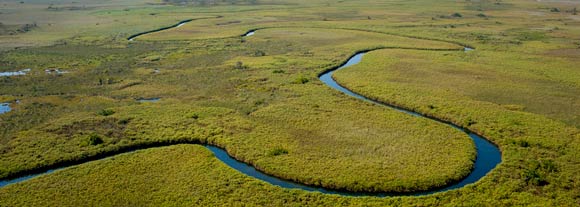
Flying over the floodplains and waterways of the Okavango Delta (photo: Vumbura Plains Lodge)
One of the world’s largest inland deltas, the Okavango covers an incredible 18,000 km2. Your stay in this sprawling, game-rich wilderness can vary greatly depending on:
- whether you choose a land-based or water-based camp
- time of year you plan on travelling
Here’s everything you need to know to help you make those decisions.
Okavango Delta Water-Based Camps
Set on the edge of permanent rivers or lagoons, the Okavango’s water-based camps offer year-round water activities such as mokoro safaris, boating and fishing. You can also go on game drives at some of these camps, although the truly remote properties (such as Xugana Island Lodge and Camp Okavango) limit their land-based activities to walking safaris on the surrounding islands.
Staying at a water-based camp you really get the feeling of being deep in the delta: mokoros take you swiftly and smoothly through narrow channels where dragonflies hover above water lilies, brilliantly patterned frogs cling to reeds, and the silence is broken by the chattering of birds or the grunt and splash of a hippo.
The focus here is on the unique beauty of the delta and its phenomenal birdlife, although there is plenty of big game too. Glide past the twitching ears of hippo, open-jawed crocodiles basking in the sun and waterbuck or situnga antelope on the reed-lined riverbanks.
Guided walks add a few more ticks to this wildlife checklist with sightings of herds of red lechwe, buffalo, elephant and zebra.

Mokoro safaris: the chance to focus in on the smaller details of this unique freshwater wilderness.
Pros:
- Year-round water activities: mokoro safaris, boating and fishing
- Tranquillity of a true water wilderness
- Phenomenal birdlife from colourful kingfishers to the Pel’s fishing owl
- Beautifully located lodges on remote, forested islands
Con:
- Some camps don’t offer game drives, but you can still go on walking safaris
Where to Stay:
- Xugana Island Lodge lies right at the heart of the Okavango Delta, with just 8 reed-and-thatch chalets overlooking a peaceful lagoon.
- Vumbura Plains, a luxurious camp with a contemporary design, offers mokoro excursions and boating, as well as game drives in an area known for excellent predator sightings.
- Jao Camp has nine spacious tent surrounded by seasonal floodplains, and offers both land and water experiences (depending on the time of year).
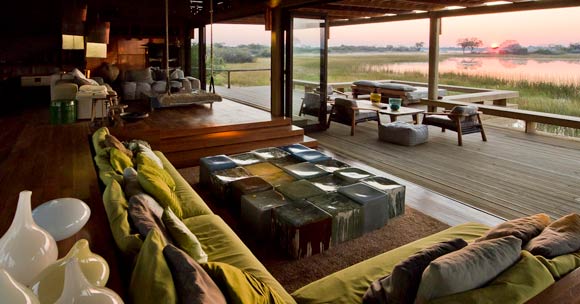
Vumbura Plains Lodge has a stylish lounge area opening onto magnificent views of the floodplains.
Okavango Delta Land-Based Camps
The floodwaters of the delta come from Africa’s third largest river, the Okavango, which originates in the highlands of Angola. As this mighty river enters Botswana it spreads out to form the fan-like delta with wide permanent waterways and ox-bow lagoons to the north, and seasonal channels further south as the waters drain away into the sands of the Kalahari Desert.
This means that not all of the delta is the watery wilderness you might expect, there are also large tracts of dry land: mosaics of Mopane woodlands, thick riverine forest, grasslands and seasonal floodplains. And it’s these drier areas and the larger islands with their rich variety of habitats that offer up the Okavango’s world-famous game viewing and thrilling wildlife sightings.
Some of the Delta’s best known land-based camps are found either on Chief’s Island – the largest of the Okavango islands and a fantastic Big 5 destination – or in private concessions which allow for off-road driving. And while many of these camps offer some water activities (in high water season), the focus here is primarily on morning and afternoon game drives in wildlife-rich regions known for consistently good predator sightings: lion, leopard, cheetah and even the African wild dog.

A game drive on the floodplains near Chitabe Camp and lion sighting near Mombo Camp
Pros:
- Experience some of Africa’s best big game viewing
- Plenty of predators including frequent lion sightings
- Mix of habitats from woodlands to floodplains and seasonal pans
- Excellent choice of luxurious tented camp accommodation
Con:
- Some land-based camps don’t offer any water activities
Where to Stay:
- Mombo Camp has 9 spacious tents on the northern point of wildlife-filled Chief’s Island. Game drives and sensational sightings are the order of the day here!
- Chitabe Camp has 8 Meru-style tents in a private concession where the interesting mix of Okavango and Kalahari habitats allows for a wonderful diversity and abundance of game.
- Camp Moremi is a comfortable tented camp offering both game drives in Moremi Reserve and motorboat safaris on the water lily-ringed Xakanaxa Lagoon and nearby delta channels.
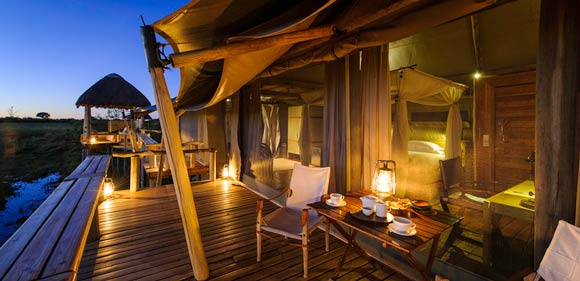
The elegant tented suites at Mombo Camp each have a private deck and thatched sala.
Linyanti Concession: Exclusive Delta-Type Experience
Lying to the northeast of the Okavango, the Linyanti offers a similar wildlife experience to the delta but in an exclusive private concession with just a handful of luxury lodges and tented camps. A place of woodlands and watercourses, this remote reserve is bisected by the Savute Channel which after a 25-year dry spell has started flowing again.
This is prime big game territory, noted in particular for the vast herds of elephant that crowd the banks of the Linyanti River during those thirsty dry-season months. Go on game drives along the floodplains and look forward to sightings of lechwe, impala, zebra and giraffe along with their ever-present predators: lion, leopards, spotted hyena and the critically endangered African wild dog.
Along with game drives, these lodges also offer seasonal water activities: stay on the Linyanti River (Kings Pool Camp) and go on relaxing cruises, sundowner in hand; or travel deeper into the remote southern regions (Savuti Camp) and paddle the waters of the Savuti Channel.
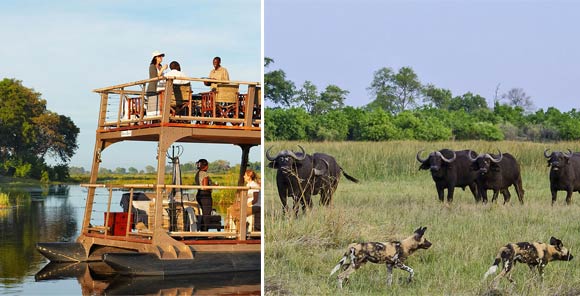
A barge cruise on the Linyanti River and wildlife seen on a game drive in this exclusive private concession.
Pros:
- This wildlife-rich private concession delivers an exclusive safari experience
- Huge herds of elephant along the Linyanti River (especially in the dry season)
- Healthy predator numbers including some of Botswana’s best wild dog sightings
- Enjoy game drives, night drives, guided walks and seasonal water activities
Con:
- Although beautiful, this area does not have the same unique feel as the wooded islands and waterways deep in the delta
Where to Stay:
- Kings Pool Camp is set on the Linanti River overlooking an oxbow lagoon, and has nine luxurious tents each with a private deck with a plunge pool and thatched sala.
- Savuti Camp sits on the bank of the once-dry Savute Channel with seven spacious tents each raised on wooden decks to make the most of their views over the water.
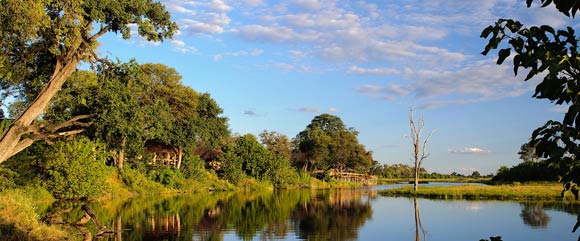
Savuti Camp has a beautiful location overlooking the once-dry Savute Channel.
Travel Fact File:
When visiting the Okavango Delta we highly recommend combining a few days at a water-based camp such as Xugana Island Lodge with a stay in wildlife-packed Moremi Reserve or the Linyanti Concession; allowing for two wonderfully different and complementary safari experiences.
The best time to visit the Okavango is during the high water season from June to October, when the waters arrive from the Angola highlands and animals flock to the delta from the dry Kalahari Desert. Botswana’s summer rains last from December to April, and this is a time of rich growth with an abundance of baby animals and predators hot on their hooves.
Contact us if you’d like to book a tour.
